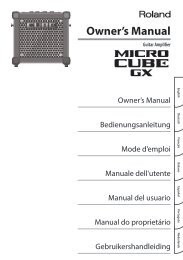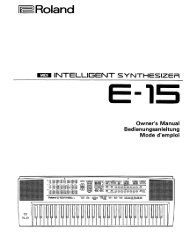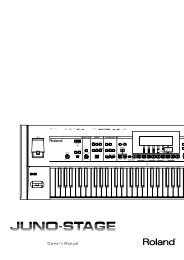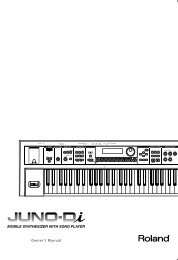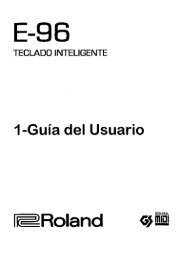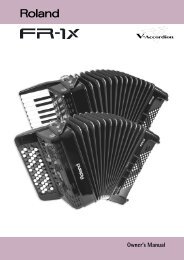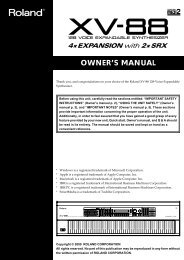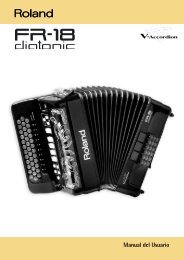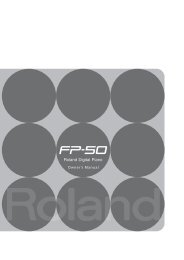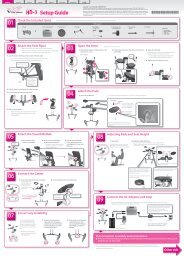Create successful ePaper yourself
Turn your PDF publications into a flip-book with our unique Google optimized e-Paper software.
6. Supplementary material<br />
■Examples of MIDI messages<br />
92 3E 5F<br />
9n is the Note On status and ‘n’ is the MIDI channel number. Since 2H = 2, 3EH = 62, and<br />
5FH = 95, this is a Note On message of MIDI CH = 3, note number 62 (note name D4) and<br />
velocity 95.<br />
C9 49<br />
CnH is the Program Change status and ‘n’ is the MIDI channel number. Since 9H = 9, and<br />
49H = 73, this is a Program Change message of MIDI CH = 10, Program number 74.<br />
EA 00 28<br />
EnH is the Pitch Bend Change status and ‘n’ is the MIDI channel number. The 2nd byte<br />
(00H=0) is the LSB of the Pitch Bend value, and the 3rd byte (28H=40) is the MSB. However<br />
since the Pitch Bend is a signed number with 0 at 40 00H ( = 64 x 128 + 0 = 8192), the Pitch<br />
Bend value in this case is<br />
28 00H - 40 00H = 40 x 128 + 0 - (64 x 128 + 0) = 5120 - 8192 = -3072<br />
If we assume that the Pitch Bend Sensitivity is set to two semitones, the pitch will change<br />
only -200 cents for a Pitch Bend value of -8192 (00 00H). Thus, this message is specifying a<br />
Pitch Bend of -200 x (-3072) ÷ (-8192) = -75 cents on MIDI CH = 7.<br />
B3 64 00 65 00 06 0C 26 00 64 7F 65 7F<br />
BnH is the Control Change status, and ‘n’ is the MIDI channel number. In Control Change<br />
messages, the 2nd byte is the controller number, and the 3rd byte is the parameter value.<br />
MIDI allows what is known as “running status,” when if messages of the the same status<br />
follow each other, it is permitted to omit the second and following status bytes. In the<br />
message above, running status is being used, meaning that the message has the following<br />
content.<br />
B3 64 00 MIDI CH = 4, RPN parameter number LSB: 00H<br />
(B3) 65 00 MIDI CH = 4, RPN parameter number MSB: 00H<br />
(B3) 06 0C MIDI CH = 4, parameter value MSB: 0CH<br />
(B3) 26 00 MIDI CH = 4, parameter value LSB: 00H<br />
(B3) 64 7F MIDI CH = 4, RPN parameter number LSB: 7FH<br />
(B3) 65 7F MIDI CH = 4, RPN parameter number MSB: 7FH<br />
■Examples of system exclusive messages and<br />
calculating the checksum<br />
<strong>Roland</strong> exclusive messages (RQ1, DT1) are transmitted with a checksum at the end of the<br />
data (before F7) to check that the data was received correctly. The value of the checksum is<br />
determined by the address and data (or size) of the exclusive message.<br />
●How to calculate the checksum<br />
The checksum consists of a value whose lower 7 bits are 0 when the address, size and<br />
checksum itself are added.<br />
The following formula shows how to calculate the checksum when the exclusive message to<br />
be transmitted has an address of aa bb cc ddH, and data or size of ee ffH.<br />
aa + bb + cc + dd + ee + ff = total<br />
total ÷ 128 = quotient ... remainder<br />
128 - remainder = checksum<br />
Setting the REVERB TYPE to HALL2 (DT1)<br />
Referring to “3. Parameter address map,” the starting address for Part Information is 01 00<br />
00 00H, and offset address of Part Information Common is 00 00H, and the REVERB TYPE<br />
address is 00 28H. Therefore, the address will be<br />
01 00 00 00H<br />
00 00H<br />
+) 00 28H<br />
01 00 00 28H<br />
Since HALL2 is parameter value 05H,<br />
F0 41 10 00H 0BH 12 01 00 00 28 05 ?? F7<br />
(1) (2) (3) (4) (5) (6) address data checksum (7)<br />
(1) Exclusive status (2) ID number (<strong>Roland</strong>) (3) device ID (17)<br />
(4), (5) model ID (D2) (6)command ID (DT1) (7) EOX<br />
Next we calculate the checksum.<br />
01H + 00H + 00H + 28H + 05H = 1 + 0 + 0 + 40 + 5 = 46(sum)<br />
46 (total) ÷ 128 = 0 (quotient)...46 (remainder)<br />
checksum = 128 - 46 (quotient) = 82 = 52H<br />
MIDI Implementation<br />
This means that the message transmitted will be F0 41 10 00 0B 12 01 00 00 28 05 52 F7.<br />
Obtaining part information data (RQ1)<br />
Referring to “3. Parameter address map,” the starting addresses for Part Information are<br />
assigned as follows.<br />
01 00 00 00H Part Info Common<br />
01 00 10 00H Part Info Part 1<br />
01 00 11 00H Part Info Part 2<br />
01 00 16 00H Part Info Part 7<br />
01 00 19 00H Part Info Part R<br />
Since the size of Part Information Part is 00 00 00 1AH, this size is added to the starting<br />
address of Part Information Part R, to obtain<br />
01 00 19 00H<br />
+) 00 00 00 1AH<br />
01 00 19 1AH<br />
Therefore, the size of the data to be obtained is<br />
01 00 19 1AH<br />
-) 01 00 00 00H<br />
00 00 19 1AH<br />
F0 41 10 00 0B 11 01 00 00 00 00 00 19 1A ?? F7<br />
(1) (2) (3) (4) (5) (6) address data checksum (7)<br />
(1) Exclusive status (2) ID number (<strong>Roland</strong>) (3) Device ID (17)<br />
(4), (5) Model ID (D2D2) (6) Command ID (RQ1) (7) EOX<br />
When the checksum is calculated in the same way as in , we have the following<br />
message to be transmitted: F0 41 10 00 0B 11 01 00 00 00 00 00 19 1A 4C F7.<br />
●Scale Tune function (Model ID : 42H (GS), address: 40<br />
1x 40H)<br />
Scale Tune is a function that makes fine adjustments to the pitch of each note C-B. Settings<br />
are made for one octave, and applied to the notes of all octaves. By making Scale Tune<br />
settings you can use tunings and temperaments other than the standard Equal<br />
Temperament. Here we give three types of settings as examples.<br />
❍Equal temperament<br />
This temperament divides the octave into 12 equal steps, and is the temperament most<br />
frequently used today, especially in western music. Initially, the Scale Tune function of this<br />
instrument is set to Equal Temperament.<br />
❍Just intonation (tonic of C)<br />
The primary triads sound more beautiful in just intonation than in equal temperament.<br />
However, this applies only in one key, and chords will be discordant if you play in a<br />
different key. The settings here are for a tonic of C.<br />
❍Arabian-type scale<br />
The Scale Tune function allow you to use various tunings of ethnic music. Here is one of the<br />
Arabian scales.<br />
Setting examples<br />
Note Equal Temp. Just (in C) Arabian-type scale<br />
C 0 0 -6<br />
C# 0 -8 +45<br />
D 0 +4 -2<br />
Eb 0 +16 -12<br />
E 0 -14 -51<br />
F 0 -2 -8<br />
F# 0 -10 +43<br />
G 0 +2 -4<br />
G# 0 +14 +47<br />
A 0 -16 0<br />
Bb 0 +14 -10<br />
B 0 -12 -49<br />
The values in the above table are in units of 1 cent. Convert these values to hexadecimal,<br />
and transmit them as exclusive data. For example to set the Scale Tune of Part 1 to an<br />
Arabian-type scale, transmit the following data.<br />
F0 41 10 42 12 40 11 40 3A 6D 3E 34 0D 38 6B 3C 6F 40 36 0F 76 F7<br />
107<br />
Appendices



